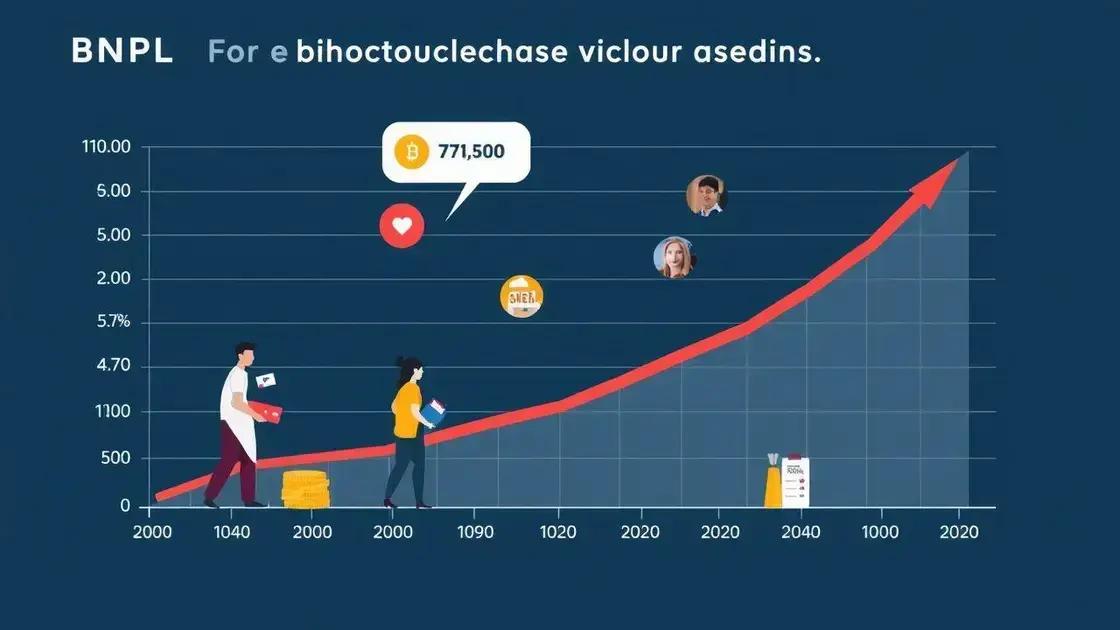BNPL usage tracking trends: What you need to know

BNPL usage tracking trends indicate a growing adoption of Buy Now Pay Later options among diverse demographics, driven by technological advancements and changing consumer preferences.
BNPL usage tracking trends are becoming essential in understanding how consumers engage with payment solutions today. Have you wondered how these trends can affect your business strategy? Let’s dive into the latest insights.
Understanding BNPL usage trends
Understanding BNPL usage trends is crucial for businesses aiming to adapt to changing consumer behaviors. As more shoppers opt for Buy Now, Pay Later services, it’s important to grasp the underlying factors driving this shift.
The Rise of BNPL Services
BNPL options have surged in popularity, particularly among younger consumers. Many are drawn to the convenience and flexibility these services offer. Unlike traditional credit, BNPL allows consumers to split their purchases into manageable installments without accruing interest. This structure has made it easier for individuals to budget their spending.
Key Factors Influencing BNPL Adoption
- Consumer preference for seamless payment experiences.
- The increasing number of retailers offering BNPL options.
- A growing awareness of financial management tools.
- Marketing strategies targeted at millennials and Gen Z.
As consumers become more comfortable with digital payments, the demand for BNPL options continues to escalate. Retailers are taking notice and adjusting their financial offerings accordingly. This trend is reshaping how purchases are made, especially in online shopping environments.
Challenges of Tracking BNPL Usage
While tracking BNPL usage trends provides valuable insights, businesses face challenges in gathering accurate data. Many providers are independent, which can complicate how information is shared and reported. Some businesses might lack the tools necessary to analyze these trends effectively.
Despite these hurdles, utilizing available analytics can help businesses stay updated with consumer preferences. Adjusting marketing strategies based on real-time data is essential for success in this competitive field.
Future Trends in BNPL
As we look ahead, it’s likely that BNPL will integrate further with fintech innovations. Enhanced financial flexibility and improved credit assessments may become standard as data analytics evolve. Businesses that leverage these changing patterns will likely outpace their competition. Exploring new BNPL functionalities could also expand customer bases and drive loyalty.
The impact of BNPL on consumer behavior

The impact of BNPL on consumer behavior is significant and multifaceted. Many consumers are shifting their purchasing habits, favoring flexibility and convenience over traditional payment methods.
Changing Shopping Preferences
As people increasingly embrace technology, the idea of paying later has grown more appealing. This is especially true for younger shoppers who tend to avoid credit cards. They are more inclined to use BNPL options due to their straightforward terms.
Key Effects on Spending Habits
- Increased average order values as shoppers feel empowered to buy more.
- More frequent purchases due to the ease of use.
- A shift toward online shopping platforms offering BNPL services.
- Potential neglect of traditional savings plans.
Consumers appreciate the ease of breaking purchases into smaller payments. This flexibility resonates with their desire for budgeting control. However, it can also create a false sense of financial security, leading some to overspend.
Demographic Trends in BNPL Usage
Different demographics show varying inclinations toward BNPL. Younger generations, particularly millennials and Gen Z, are driving this market. They value financial technologies that offer transparency and instant gratification when making purchasing decisions.
Moreover, these consumers often engage in lifestyle purchases, such as clothing and electronics, showcasing a preference for products that enhance their experiences. Understanding these behaviors can help retailers tailor their marketing strategies effectively.
Potential Drawbacks of BNPL
While there are advantages, BNPL also brings some concerns. Some consumers may struggle with debt due to the lack of awareness about repayment schedules. Building a strong understanding of how these payment options work is essential to avoid financial pitfalls. Encouraging responsible spending and offering education can help mitigate these risks.
Challenges in tracking BNPL usage
Tracking BNPL usage presents several challenges for businesses and financial institutions. Many companies struggle with obtaining accurate data, which is essential for understanding consumer trends.
Diverse Providers and Platforms
One major issue is the variety of BNPL providers. Each has its own system and reporting methods, making it hard for businesses to consolidate data effectively. This fragmentation can lead to discrepancies in how usage is measured, impacting the insights drawn from it.
Lack of Standardized Metrics
- Companies often have different definitions for key metrics.
- The absence of a unified reporting framework complicates comparisons.
- Without standard metrics, trends may appear inconsistent or misleading.
As a result, businesses might find it hard to gauge their performance accurately. Understanding customer behavior becomes tricky without reliable data.
Consumer Privacy Concerns
Another layer of complexity involves consumer privacy. Shoppers are increasingly concerned about how their data is used and shared. Many BNPL services collect sensitive information, and customers may hesitate to allow tracking, further complicating data collection efforts.
Businesses must navigate these privacy issues carefully, ensuring compliance while still trying to gather insights. This balance is crucial to maintain customer trust.
Technology and Integration Challenges
Integrating BNPL data with existing financial systems poses additional hurdles. Companies often use a mix of legacy systems and new technologies. This can lead to compatibility issues, making it more difficult to track usage effectively.
Investing in advanced analytics tools could help, but it requires resources and a commitment to data-driven decision-making. As the BNPL market evolves, addressing these challenges will be necessary for success.
Future predictions for BNPL trends

Future predictions for BNPL trends suggest that this payment method will continue to evolve, becoming a significant player in the financial landscape. As more consumers use BNPL, businesses must adapt to stay competitive.
Increased Adoption Among Diverse Demographics
As awareness of BNPL spreads, its adoption is expected to rise across various age groups. While younger consumers currently dominate the market, older generations are beginning to explore these payment options. This will broaden the customer base and diversify shopping habits.
Technological Advancements in Payment Systems
- Integration of artificial intelligence to enhance payment processes.
- More seamless and user-friendly interfaces for BNPL platforms.
- Real-time data analytics for better consumer insights.
- Emergence of innovative features such as pay-per-use models.
These advancements will likely improve the customer experience, making it easier for them to manage their purchases. Companies that embrace these innovations are likely to outperform competitors.
Greater Regulatory Scrutiny
As BNPL grows, so does the attention from regulators. Expect to see more consistent guidelines that promote responsible lending and consumer protection. These regulations will require companies to ensure clarity in terms and conditions, which will help consumers make informed decisions.
Facing regulatory pressure, companies may need to adapt quickly to comply. This could lead to a more robust and transparent BNPL market.
Emergence of Alternative Payment Models
Future trends may also see the rise of alternative payment models alongside BNPL. Options like subscriptions or even installment plans tailored for specific products could gain traction. As consumers seek more flexibility, businesses will need to innovate to meet their demands.
Brands that can offer diverse payment options will likely capture more market share and address different customer needs effectively.
In summary, the future of BNPL is bright, with many exciting trends on the horizon. As more consumers adopt these payment options, businesses must stay agile to meet evolving demands. Technological innovations will enhance customer experiences, making financial transactions smoother and simpler. However, as the market grows, regulatory scrutiny will increase, prompting companies to adapt and ensure responsible lending practices. Organizations that embrace these changes will likely succeed and thrive in the competitive landscape. Overall, understanding these trends is essential for anyone looking to navigate the world of BNPL effectively.
FAQ – Frequently Asked Questions about BNPL Trends
What is BNPL and how does it work?
BNPL stands for Buy Now Pay Later, allowing consumers to make purchases and pay for them in installments without interest.
Who typically uses BNPL services?
BNPL services are popular among younger consumers, especially millennials and Gen Z, who prefer flexible payment options.
What are the risks associated with BNPL?
Risks include overspending and accumulating debt due to the ease of making purchases without immediate payment.
How can businesses benefit from offering BNPL?
Businesses can increase sales, attract new customers, and improve customer satisfaction by providing flexible payment options through BNPL.






